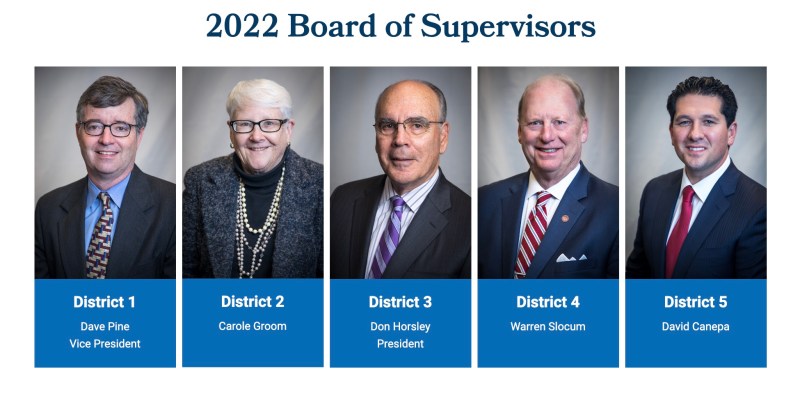|
Getting your Trinity Audio player ready...
|
PRESS RELEASE. From the San Mateo County Supervisor’s meeting on Tuesday, November 1st, 2022 at 9:00am.
The Board of Supervisors voted 5-0 to support oversight of the Sheriff’s Office and direct staff and the ad hoc committee to return to the full Board with a proposal that involves both an Inspector General and a board.
AGENDA
To: Honorable Board of Supervisors
From: Supervisor Dave Pine, District 1
Supervisor Warren Slocum, District 4
Subject: Study Session on Sheriff Office Oversight Models
RECOMMENDATION:
Receive report, presentation, and public comment on Sheriff Office Oversight Models.
BACKGROUND:
On September 30, 2020, Governor Newsom signed Assembly Bill (AB) 1185. The law added a new Section 25303.7 the California Government Code. Among other things, Section 25303.7 vests Boards of Supervisors with discretion provide for oversight of the county Sheriff by creating (a) an Oversight Board, (b) an Inspector General, or (c) both. AB 1185 took effect on January 1, 2021.
Notably the law also acknowledges the longstanding statutory and constitutional principle that the Board of Supervisors cannot interfere with an independently elected Sheriff’s core law enforcement functions.
To date, AB 1185 has had limited application, with no clear implementation examples in any California county. However, seven counties have implemented some alternative form of oversight broadly consistent with AB 1185’s three aforementioned options (Board, Inspector General and/or both). These options emphasize three different oversight functions/goals:
• Transparency: providing members of the public with access to data and reports;
• Community Engagement: gathering public input, conducting outreach and actively educating the public; and
• Fact-finding and Recommendations: looking at particular policies or incidents and providing feedback.
DISCUSSION:
As noted, there are currently seven counties with some form of oversight body focused in whole or in part on their Sheriff’s Office. Most of these entities were recently created by large urban counties, and it is therefore difficult to analyze their effectiveness or the potential utility of these models for San Mateo County. Nevertheless, this memorandum provides a very brief overview of how these counties have utilized the three models, with embedded hyperlinks leading to more detail.
Model 1: Inspector General
Orange County uses an inspector general model (the Office of Independent Review (“OIR”). According to its website, the OIR “monitors and reviews specific incidents, systemic issues, and assists in developing and assessing corrective actions that address high risk practices related to the Departments it oversees.” It performs these tasks for five County agencies: Sheriff, Probation, the District Attorney, the Public Defender and Social Services.
OIR is run by County employees and Orange County hired a new OIR director this month.
Sacramento County, too, uses this Inspector General model According to its website, the “primary function of the Office of Inspector General is to ensure the integrity of the citizen complaint process for all misconduct complaints regarding employees of the Sacramento County Sheriff’s Office.” The website also notes that the Sheriff’s Office Internal Affairs Bureau is the primary investigative body for all complaints of misconduct,” but that the Inspector General “will provide independent and objective review of those complaints to ensure they are conducted thoroughly, fairly, and judiciously.” Sacramento County contracted with a new Inspector General this summer. There have been periods where the position has been vacant. Last year, Sacramento County added a citizen commission to advise the Inspector General in some manner.
Santa Clara County also uses a similar model, which only recently began its work. Its work is also done by a contractor, and it too has an advisory citizens committee.
Model 2: Oversight Board
San Diego County uses an oversight board model without an inspector general.
Its Citizens’ Law Enforcement Review Board consists of 11 members appointed by the Board of Supervisors. Its website states that “San Diego County voters established the Citizens’ Law Enforcement Review Board (CLERB) in 1990 to independently and impartially investigate citizen complaints against San Diego County Sheriff’s deputies and probation officers.” The website also notes that CLERB members cannot be affiliated with the Sheriff’s Department, Probation Department, or the County of San Diego and that they are nominated by the County’s Chief Administrative Officer and appointed by the Board of Supervisors. Three County employees support the Review Board: an executive officer, an investigator, and an administrative assistant.”
Model 3: Oversight Board and Inspector General
Sonoma County uses a dual Inspector General/Oversight Board model. It created an oversight office in 2015, but the voters enacted Measure P in 2020, which replaced it with the Office of Law Enforcement Review and Outreach (“OLERO”). OLERO is staffed by County employees. However, Measure P was challenged based on concerns that the County did not confer with its unions and OLERO was essentially on hold until that dispute was resolved this summer. The Board of Supervisors appoints an 11-member advisory council to advise the OLERO Director (also appointed by the Board of Supervisors).
San Francisco uses a similar model, with an oversight board that oversees an inspector general. It was created by a voter measure in 2020, but only started meeting this summer.
Los Angeles County also has both an Office of Inspector General and a Citizens Oversight Commission with paid staff. The Office of Inspector General (OIG) website states that the OIG was established in 2014 “as part of the [LA] Board of Supervisors’ duty to supervise the official conduct of County officers under Government Code section 25303,” and that the “purpose of the Office is to promote constitutional policing and the fair and impartial administration of justice, and to facilitate the Board of Supervisors’ responsibility.” According to its website, the OIG provides “independent and comprehensive oversight, monitoring of, and reporting about the Sheriff’s Department and Probation Department . . . and serve as the investigative arm of the Los Angeles County Sheriff Civilian Oversight Commission and Probation Oversight Commission.” It also has had a nine member Civilian Oversight Commission since 2016 with paid staff. “The Commission provides ongoing review, analysis and oversight of the Sheriff’s Department’s policies, practices and procedures.”
Other counties remain undecided. Santa Cruz County and Alameda County appear to be exploring some form of oversight. Marin and Solano Counties have discussed oversight but do not appear to be actively exploring it. Contra Costa has recently indicated that it would not be pursuing an oversight body. Many others do not appear to have considered creating new oversight bodies.
Supervisors Establish Ad Hoc Committee to Consider Civilian Oversight for the San Mateo County Sheriff’s Office
More on SMCo Sheriff Office on Coastside Buzz
2022 Board of Supervisors









